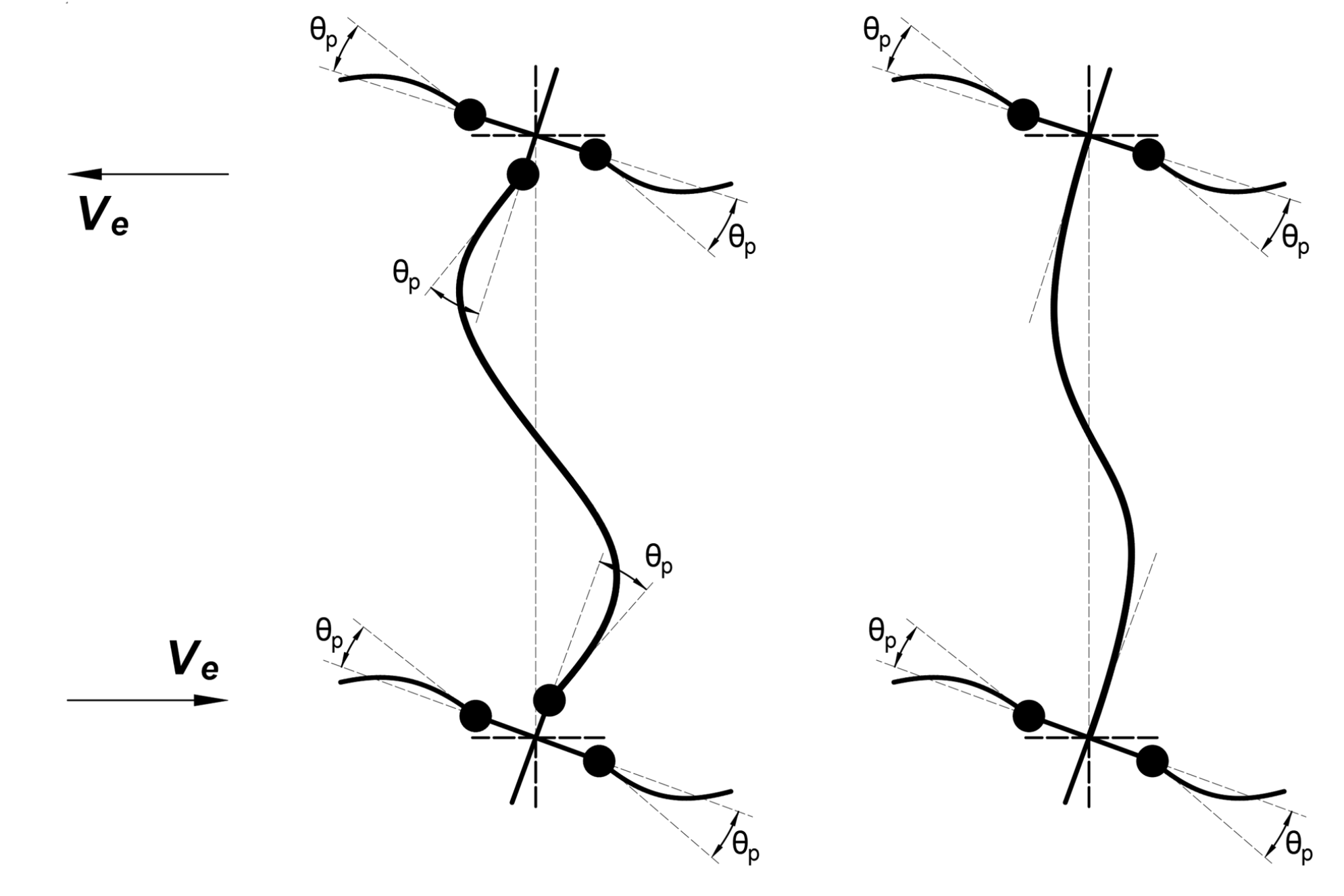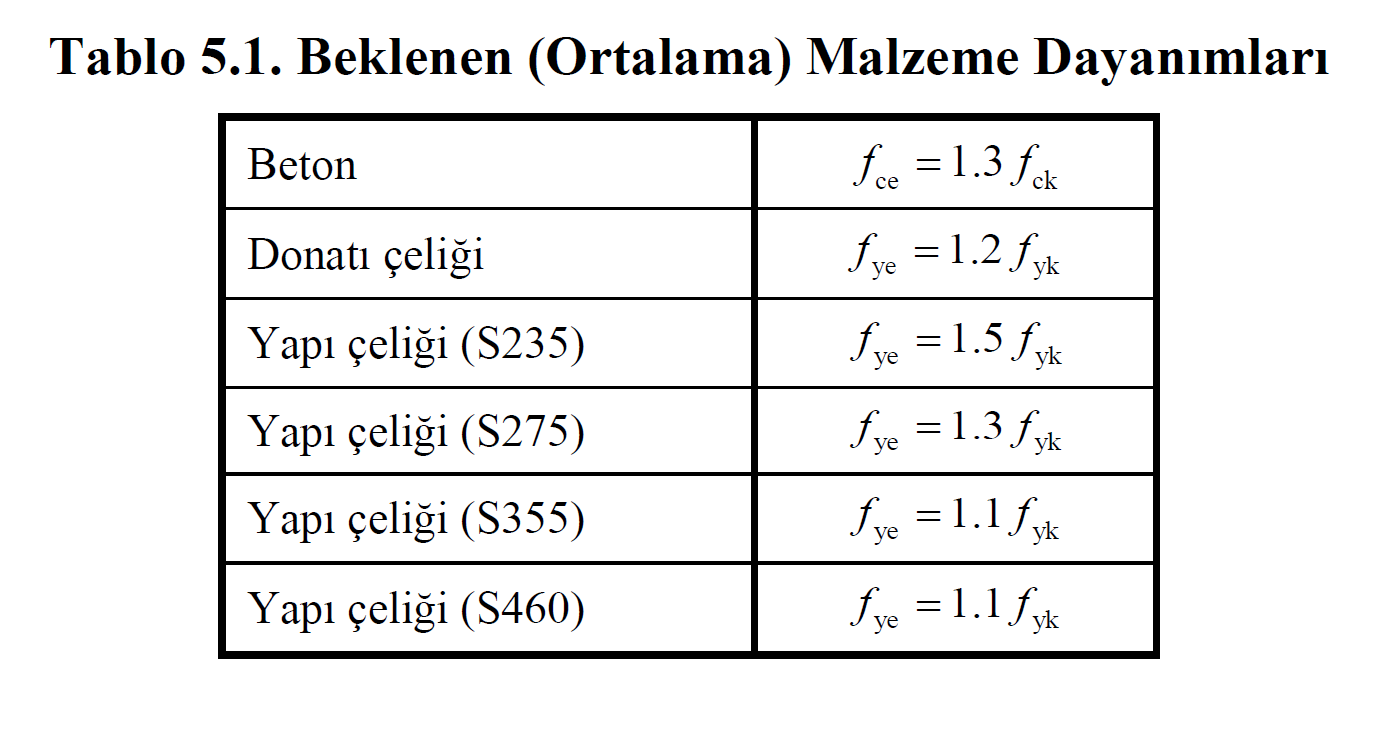Internal Force Conditions (5.8.1.5)
Column, beam and curtain shear force demands are automatically calculated according to the performance point.
The ductility checks are made automatically by calculating the column, beam and curtain shear force capacities.
SİMGELER
Ach = Gross cross-sectional area of the curtain without a gap, each curtain piece in a tie-beam curtain, each floor or each floor piece in a hollow floor
Aw = Column cross-section effective body area
bw = Trunk width of the beam
d = Useful height of the beam
fck = Characteristic cylinder compressive strength of concrete
fyk = Characteristic yield strength of reinforcing steel
fce = Average (expected) compressive strength of concrete
fye = The average (expected) yield strength of steel
My = Effective torque
Ve = Shear force calculated as a result of thrust analysis at column, beam and curtain
Vr = Shear strength of column, beam or curtain section
ρsh = Volumetric ratio of horizontal web reinforcements in the wall
θp = Plastic rotation value
It is shown that the internal force demands calculated as specified in TBDY 5.8.1.5 are smaller than the internal force capacities defined in Chapter 7 of TBDY. For new buildings, while calculating the internal force capacities, the average (expected) material strengths given in Table 5.1 are taken as basis.
In order for the elements to behave ductile, there should be no damage under the influence of shear force. For this reason, the shear strength of the element must be greater than the shear force that occurs in the formation of plastic hinges. This cutting force value is the value of the cutting force at the performance point of the element. The following figure shows the shear force V caused by the moment My, resulting from the plastic at both ends of the beam.
.png?inst-v=fdb0b471-f371-4ec4-9cc2-f9eb0ed4ce05)
The shear force demand generated as a result of the thrust analysis in columns, beams and curtain elements is shown as Ve. And its value is the value of the shear force at the performance point. The above picture shows the shear forces generated in the beam as a result of the beam plasticization.
The shear force that occurs in the columns may vary depending on the beam or column plasticization. The plasticization state that constitutes the Ve value for the columns is shown in the picture below.

According to TBDY 5.8.1.5 and 7.4.5.2, in order for a beam to exhibit ductile behavior, the value V of the shear force generated at the performance point of the beams must be less than the beam shear strength Vr. The beam shear strength is explained in detail under the heading Vr. While calculating Vr for new buildings, the average (expected) material strengths given in Table 5.1 are taken as basis. When calculating Vr for existing buildings, the current material strengths and Knowledge Level Coefficients given in Table 15.1 are used.

According to TBDY 5.8.1.5 and 7.3.7.5, in order for a column to exhibit ductile behavior, the value V of the shear force generated at the performance point of the columns must be less than the beam shear strength Vr. Column shear strength is described in detail under the heading Vr. While calculating Vr for new buildings, the average (expected) material strengths given in Table 5.1 are taken as basis. When calculating Vr for existing buildings, the current material strengths and Knowledge Level Coefficients given in Table 15.1 are used.

According to TBDY 5.8.1.5 and 7.6.6.3, in order for a column to exhibit ductile behavior, the value V of the shear force generated at the performance point of the columns must be less than the beam shear strength Vr. Shear strength in walls is found by Vr TBDY Equation 7.17. It is explained in detail under the heading of finding the curtain shear strength Vr. While calculating Vr for new buildings, the average (expected) material strengths given in Table 5.1 are taken as basis. When calculating Vr for existing buildings, the current material strengths and Knowledge Level Coefficients given in Table 15.1 are used.


Table 5.1 of TBDY used to calculate internal force capacities in new buildings is given below.

The Knowledge Level Coefficients used to calculate the internal force capacities in existing buildings TBDY Table 15.1 is given below.

